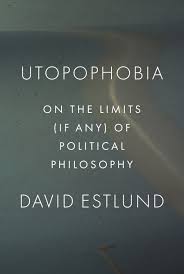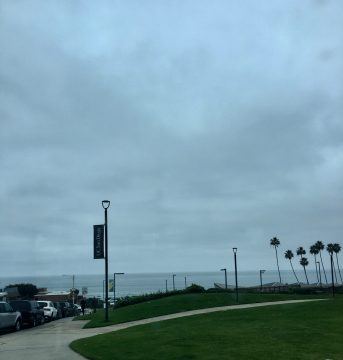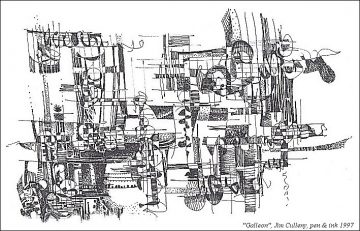
Driving to Innsbruck on the A22 Autobahn in fog in November of 2013.

Driving to Innsbruck on the A22 Autobahn in fog in November of 2013.
by Akim Reinhardt
Stuck is a weekly serial appearing at 3QD every Monday through early April. The Prologue is here. The table of contents with links to previous chapters is here.

This song has been with me, quite thoroughly, for two weeks now. There should be more to talk about. Such as Blind Faith, rock n roll’s first super group, cobbled together from members of Cream (guitarist Eric Clapton, drummer Ginger Baker), Traffic (singer/keyboardist Steve Winwood), and Family (bassist Ric Grech). How they sparkled brightly and burned out after just one album and tour. Or Winwood specifically, author and singer of this particular song. A child prodigy of pop, he joined the Spencer Davis Group when he was only 14 years old, soon penning and singing two hit singles: “Gimme Some Lovin’” (later covered by the Blues Brothers) and “I’m a Man” (later covered by Chicago). Or I could talk about the song itself. Over five minutes long, it is at turns coarse and lush, rigid and ethereal, intense and contemplative and euphoric. Or perhaps I could share something about who I am. Stories about being on the water, relatively few in number, yet still rich in moments of bonding with family and friends, of self-definition, of living without time, of killing with rods and hooks.
But instead, all I have is this one lyric.
Waiting in our boats to set sail
Days upon days of obsession hang upon this short, taut thread. Guitars, organ, drums, bass, vocals spinning round those seven words. One small dot, dark and unmoving amid the raging, whirring maelstrom of all things, demanding my senses heed and bend to it.
Waiting in our boats to set sail
The quiet anguish of gently rocking between blue skies and placid water for want of summer wind. The holy promise, too great to speak aloud, of sailing into all that is vast and open and free, already so complete and perfectly oblivious to my bow, should it ever come to slice through air and wave. Read more »
by Tim Sommers
 So, here’s a game. Try to imagine: “What unbelievable moral achievements might humanity witness a century from now?” Now, discuss.
So, here’s a game. Try to imagine: “What unbelievable moral achievements might humanity witness a century from now?” Now, discuss.
“The trick, of course, is that if you can seriously contemplate its occurring, you are thinking too small, or so history suggest.” So says David Estlund who proposes “The Unbelievable Moral Progress Game” in his new book “Utopophobia: On the Limits (If Any) of Political Philosophy”.
The argument that political philosophy is, or theories of justice are, too often unrealistic is familiar enough. Estlund turns that argument on its head. He argues (among other things) that, at least sometimes, political philosophy is not unrealistic enough. Or, at least, that we should not be afraid to imagine the highly-unlikely, even the impossible, when thinking about what might be possible for us morally and politically.
Estlund’s previous book, “Democratic Authority”, besides being an influential, admirably clear, and widely read work on democracy is the source of the word. “Epistocracy.” It means the rule of the knowledgeable. You may have heard of it. He’s against it.
In “Utopophobia”, he takes head-on on a wide-variety of entertaining, often challenging, topics around the theme, obviously, of the wide-spread allergic reaction to utopianism in our culture. (In an earlier column, I used his “fallacy of approximation”. (“What if Equality of Opportunity is a Bad Idea?”) To simplify a bit, “It is not the case that where the first best solution is not available, the second best is always to be preferred.”) But this is not a book review. Let’s play the game.
There are real cases of unbelievable moral progress. Estlund mentions (among other things) the abolition of slavery and the legalization of same sex marriage. I asked a number of people for their thoughts on what the next great leap forward might me. (The list of those people is at the bottom.) This is some of what some of them said. Read more »
by Adele A Wilby
 The translated versions from Tamil into English of Perumal Murugan’s two books, One Part Woman and the The Story of A Goat, weave stories of the complex life of the rural people of South India in an engaging and highly readable form.
The translated versions from Tamil into English of Perumal Murugan’s two books, One Part Woman and the The Story of A Goat, weave stories of the complex life of the rural people of South India in an engaging and highly readable form.
Murugan’s use of imaginary language in both books effectively brings to life the rural context and lifestyle of poor farmers. Likewise, they are infused with subtle references to the caste system in India. But while the caste system is a crucial issue that warrants the scrutiny that it gets, it is but one theme in Murugan’s complex novels; they are, in effect, thematically layered narratives and they deal with the issues common to various degrees in most societies: the relationship between the individual and society and the state,the disciplining force of social norms and expectations and the extent to which religion plays a crucial role in the lives of the people. In doing so, Murugan creates a fiction that has, at its core, a human essence which makes his novels highly accessible and relatable.
In One Part Woman, Murugan explores the sad tale of a young couple, Kali and Poona, married for twelve years, and childless. By choosing this topic as his main theme, Murugan has hit on a sensitive issue and he examines it from many cultural perspectives. Read more »
by Chris Horner
 The political philosophy, and more importantly, political practice that took root in the wake of the ‘Age of Revolutions’ (say 1775-1848) was liberalism of various kinds: a commitment to certain principles and practices that eventually came to seem, like any successful ideology, a kind of common sense. With this, however, came a growing sense of dissatisfaction with what it seemed to represent: ‘bourgeois society’. Here is a paradox: at the very point at which the Enlightenment promise of the free society seemed to be coming true, discontent with that promise, or with the way it was being fulfilled, took hold. This was a sense that the modern citizen and subject was somehow still unfree. If this seems at least an aspect of how things stand with us in 2020 it might be worth looking back, for doubts about the liberal project have accompanied it since its inception.
The political philosophy, and more importantly, political practice that took root in the wake of the ‘Age of Revolutions’ (say 1775-1848) was liberalism of various kinds: a commitment to certain principles and practices that eventually came to seem, like any successful ideology, a kind of common sense. With this, however, came a growing sense of dissatisfaction with what it seemed to represent: ‘bourgeois society’. Here is a paradox: at the very point at which the Enlightenment promise of the free society seemed to be coming true, discontent with that promise, or with the way it was being fulfilled, took hold. This was a sense that the modern citizen and subject was somehow still unfree. If this seems at least an aspect of how things stand with us in 2020 it might be worth looking back, for doubts about the liberal project have accompanied it since its inception.

Three political philosophies were contending for the inheritance of the age of revolution: Radical/egalitarian, Conservative and Liberal. For conservatives, after the more extreme response of figures like Joseph de Maîstre (1753-1821) who wanted the speedy eradication of the fact and the idea of the revolution; a total return and restoration of the ancien regime, a more pragmatic ‘reaction’ remained possible. Edmund Burke (1729-97) stands here in an interesting position. No bone-headed follower of despotism, he had argued the case of the American colonists in their Revolution with great eloquence. But things changed when he considered events in France. His Reflections on the Revolution in France (1790) stems from a horror at many things, not only sans culottes rampaging through the Tuileries, but also the pretensions of the ‘democratic’ revolutionary elite. He can be seen as a mere counterrevolutionary, yet the conservative tradition to which he belongs (which includes Carlyle and Ruskin) did develop a critique of the liberal individualism of the new century. Read more »
by Claire Chambers
 In Owen Bennett-Jones’s ten-part podcast, The Assassination, which he made for the BBC World Service in 2017, listeners become immersed in the circumstances around the murder of Benazir Bhutto ten years earlier. They learn of the security concerns, sectarian hatred, and patriarchal demands faced by even this most privileged woman. Benazir, a dynastic leader from Pakistan’s best-known political family, was perceived by some extremists as belonging to the despised sect of Shiism because her Iranian mother was Shia. She and her husband Asif Ali Zardari – ‘Mr Ten Percent’ – were rightly under investigation on extensive corruption charges. On top of that, misogynists were incensed by her claims to power; indeed, her son Bilawal has written that ‘she was held to a different standard just because she was a woman’.All that being said, the most alarming danger at this authoritarian moment in 2007 was that the powerful wished to silence her calls for the reinstatement of democratic rule in Pakistan.
In Owen Bennett-Jones’s ten-part podcast, The Assassination, which he made for the BBC World Service in 2017, listeners become immersed in the circumstances around the murder of Benazir Bhutto ten years earlier. They learn of the security concerns, sectarian hatred, and patriarchal demands faced by even this most privileged woman. Benazir, a dynastic leader from Pakistan’s best-known political family, was perceived by some extremists as belonging to the despised sect of Shiism because her Iranian mother was Shia. She and her husband Asif Ali Zardari – ‘Mr Ten Percent’ – were rightly under investigation on extensive corruption charges. On top of that, misogynists were incensed by her claims to power; indeed, her son Bilawal has written that ‘she was held to a different standard just because she was a woman’.All that being said, the most alarming danger at this authoritarian moment in 2007 was that the powerful wished to silence her calls for the reinstatement of democratic rule in Pakistan.
 As she returned to her country after eight years of self-imposed exile in Dubai, Benazir reflected in her posthumously-published memoir Reconciliation that she ‘understood the dangers and the risks’. Yet nothing could have prepared her for the violence that erupted within hours of her arrival in the fatherland. What Benazir called her ‘caravan of democracy’, a specially adapted flatbed truck with an escape hatch through which she could wave to the vast crowds gathered to greet her, was attacked by a suicide bomber. The unsuccessful sortie against her on 19 October resulted in the deaths of 179 people in Karachi, including more than fifty of Benazir’s volunteers who were acting as human shields. It is chilling to read Benazir’s words: ‘It was the worst sight I had ever seen, and I’m sure the worst sight that I will ever see as long as I live’. She was right in this assertion, as she would only live for ten more weeks Read more »
As she returned to her country after eight years of self-imposed exile in Dubai, Benazir reflected in her posthumously-published memoir Reconciliation that she ‘understood the dangers and the risks’. Yet nothing could have prepared her for the violence that erupted within hours of her arrival in the fatherland. What Benazir called her ‘caravan of democracy’, a specially adapted flatbed truck with an escape hatch through which she could wave to the vast crowds gathered to greet her, was attacked by a suicide bomber. The unsuccessful sortie against her on 19 October resulted in the deaths of 179 people in Karachi, including more than fifty of Benazir’s volunteers who were acting as human shields. It is chilling to read Benazir’s words: ‘It was the worst sight I had ever seen, and I’m sure the worst sight that I will ever see as long as I live’. She was right in this assertion, as she would only live for ten more weeks Read more »
Leroy “Lee” Edward Hood is a Senior Vice President and Chief Science Officer, Providence St. Joseph Health; Chief Strategy Officer, Co-founder and Professor at Institute for Systems Biology. Previously Dr. Hood served on the faculties at the California Institute of Technology (Caltech) and the University of Washington. Dr. Hood is a world-renowned scientist and a recipient of the National Medal of Science in 2011. He has developed ground-breaking scientific instruments which made possible major advances in the biological sciences and the medical sciences. These include the first gas phase protein sequencer, a DNA synthesizer, a peptide synthesizer, the first automated DNA sequencer, ink-jet oligonucleotide technology for synthesizing DNA and nanostring technology for analyzing single molecules of DNA and RNA. He is a member of the National Academy of Sciences, the National Academy of Engineering, and the National Academy of Medicine. Of the more than 6,000 scientists worldwide who belong to one or more of these academies, Dr. Hood is one of only 20 people elected to all three.
Azra Raza, author of The First Cell: And the Human Costs of Pursuing Cancer to the Last, oncologist and professor of medicine at Columbia University, and 3QD editor, decided to speak to more than 20 leading cancer investigators and ask each of them the same five questions listed below. She videotaped the interviews and over the next months we will be posting them here one at a time each Monday. Please keep in mind that Azra and the rest of us at 3QD neither endorse nor oppose any of the answers given by the researchers as part of this project. Their views are their own. One can browse all previous interviews here.
1. We were treating acute myeloid leukemia (AML) with 7+3 (7 days of the drug cytosine arabinoside and 3 days of daunomycin) in 1977. We are still doing the same in 2019. What is the best way forward to change it by 2028?
2. There are 3.5 million papers on cancer, 135,000 in 2017 alone. There is a staggering disconnect between great scientific insights and translation to improved therapy. What are we doing wrong?
3. The fact that children respond to the same treatment better than adults seems to suggest that the cancer biology is different and also that the host is different. Since most cancers increase with age, even having good therapy may not matter as the host is decrepit. Solution?
4. You have great knowledge and experience in the field. If you were given limitless resources to plan a cure for cancer, what will you do?
5. Offering patients with advanced stage non-curable cancer, palliative but toxic treatments is a service or disservice in the current therapeutic landscape?
by Shadab Zeest Hashmi
 Gibraltar in the background, I pose sideways, wearing a Spanish Chrysanthemum claw in my hair, gitana style, taking a dare from my husband. The photo is from an August afternoon, captured in the sun’s manic glare. My shadow in profile, with the oversized flower behind my ear, mirrors the shape of Gibraltar, Jabl ut Tariq or “Tariq’s rock.” An actual visit to Gibraltar is more than a decade ahead in the future. I would spend years researching the civilization of al Andalus (Muslim Spain, 711-1492) and publish a book about the convivencia of the Abrahamic people before finally setting foot on Gibraltar. “In Cordoba,” I write, “I’m inside the tremor of exile— the primeval, paramount home of poetry” and that “I am drawn to the world of al Andalus because it is a gift of exiles, a celebration of the cusp and of plural identities, the meeting point of three continents and three faiths, where the drama of boundaries and their blurring took place.” At the heart of this pursuit is my own story, one that is illuminated only recently when I see in Gibraltar more facets of my own exile and encounter with borders.
Gibraltar in the background, I pose sideways, wearing a Spanish Chrysanthemum claw in my hair, gitana style, taking a dare from my husband. The photo is from an August afternoon, captured in the sun’s manic glare. My shadow in profile, with the oversized flower behind my ear, mirrors the shape of Gibraltar, Jabl ut Tariq or “Tariq’s rock.” An actual visit to Gibraltar is more than a decade ahead in the future. I would spend years researching the civilization of al Andalus (Muslim Spain, 711-1492) and publish a book about the convivencia of the Abrahamic people before finally setting foot on Gibraltar. “In Cordoba,” I write, “I’m inside the tremor of exile— the primeval, paramount home of poetry” and that “I am drawn to the world of al Andalus because it is a gift of exiles, a celebration of the cusp and of plural identities, the meeting point of three continents and three faiths, where the drama of boundaries and their blurring took place.” At the heart of this pursuit is my own story, one that is illuminated only recently when I see in Gibraltar more facets of my own exile and encounter with borders.
On the flight from Karachi to Frankfurt, before my first train trip to Spain, I’m in my silk shalwar kameez and high heels, a young newlywed: halved, doubled, protean, wearing a new identity I have not yet divined or defined. When the immigration officer in Frankfurt asks questions, my husband who is half-German, responds in German and I in English. No, I do not speak German. Yes, we were married two weeks ago. My passport has my maiden name, but I have now adopted my husband’s family name Hashmi. Yes, our flight out of Europe is from Frankfurt and we will fly to the USA where we will live.
A few months earlier, when I designed my wedding cards, I had an emotional exchange with my father on the matter of changing names; it was a difficult decision to give up my family name for my husband’s. The topic of my name was fraught. My first name was my father’s gift, my middle name was my mother’s and the family name held the possibility of either reinforcing my attachment to my birth family by retaining it after marriage or giving it up as a gesture to honor my husband’s family. I chose the latter. Read more »
by Niall Chithelen

Night Bus—Beijing
The night bus takes you across the city in a straight shot. This city has straight shots, it’s wide across, you span some middle area, and who knows where the night bus goes when you leave.
The night bus shows up at odd times; you realized shamefully late that there even was a schedule. The other people who take the night bus aren’t like you, not taking it for your reasons, whatever those reasons are. They take their folded-up delivery bikes and sigh off at their stop. You stand up a few blocks out and then swing out, tilting home.
The night bus is where you collect yourself after a social evening, where the emptied streets remind you that you are anonymous and you return to the grey neighborhood where your footsteps are loud after midnight. Usually you are grateful for this strange nighttime routine. Sometimes you wish you stayed longer among the neon lights.
Seaside—San Diego

In the daylight, this route takes you up and down a hill along the water and you can breathe some ocean breaths. Bus or no bus, this is a sight better than most people get to see today. You’ve stepped in this ocean only once, though, dunked yourself into it, nervous, unsure what you had to lose; mostly you’ve seen it through windows or past stone walls.
On the way back, in the dark, you don’t notice the water. It’s not window time anymore, but instead looking down at your black plastic grocery bag time, or your phone, where you have pulled up a video that will stop playing if you change applications, so that you don’t check your messages so often. But you’re not good at not checking. You change applications. It’s a shame you’re heading home for no reason other than being done, out there.
As you step off at your inland corner, the ocean waits quietly, not too far away, wondering when you might return again.
Line 52—Tompkins County, New York
My winter boots are much too big, not in fit, just in general, so I’ve ruined some pretty nice shoes treading carefully during snow season. To or from work, I saw a bus I never took, bus 52, from Ithaca to Caroline. I suppose Caroline is a town, but maybe it isn’t—I was struck with the thought of the bus, plaintive, searching:
Line 52: Caroline
please come home
by Ariane Koek

The architect Sou Fujimoto thinks of space as ‘densities’ and says architecture ‘is like handling the densities of the air’
“An endless sea of possibilities…of particles jumping in and out of existence” – that’s the description of space by the physicist Bilge Demirköz, who helped build the Alpha Magnetic Spectrometer (AMS) detector on the International Space Station, thinks of space.
“Matter is creation, its evolution, it’s nature, it’s us” – that’s how Fashion designer Iris van Herpen describes matter. The physicist Michael Doser describes matter, the subject of his life’s work, as ‘massive, compace, heaty, light, transparent, filmy, an illusion.”
Different ways of looking at the same phenomena, revealing different ways of knowing and experiencing it through the mind or body or both. Laid out side by side in my book Entangle: Physics and the Artistic Imagination, seven physicists and seven artists individually explore what seven different phenomena mean to them. Their interviews reveal the differences as well as connections of seeing the same phenomena through different eyes. It is my belief that it is in the connections, the differences, and the gaps in between, that the two most unique aspects of being human thrive and grow – the sacred space of the imagination and creativity. Read more »
Stuck is a weekly serial appearing at 3QD every Monday through early April. The Prologue is here. The table of contents with links to previous chapters is here.
by Akim Reinhardt
 Most people associate the Cold War with several decades of intense political and economic competition between the United States and Soviet Union. A constant back and forth punctuated by dramatic moments such as the Berlin Airlift, the Berlin Wall, the arms race, the space race, the Bay of Pigs, the Cuban Missile Crisis, Nixon’s visit to China, the Olympic boycotts, “Mr. Gorbachev, tear down this wall!” and eventually the collapse of the Soviet system.
Most people associate the Cold War with several decades of intense political and economic competition between the United States and Soviet Union. A constant back and forth punctuated by dramatic moments such as the Berlin Airlift, the Berlin Wall, the arms race, the space race, the Bay of Pigs, the Cuban Missile Crisis, Nixon’s visit to China, the Olympic boycotts, “Mr. Gorbachev, tear down this wall!” and eventually the collapse of the Soviet system.
But on the home front, the Cold War was often less about politics and economics and more about culture and society. It was a time of Us vs. Them, of Right vs. Wrong. Certain cows were sacred, others were evil, and woe be unto those who milked the wrong teat. The Cold War was about American society demanding conformity, and persecuting those who did not play along.
The Second Red Scare (ca. 1947–57) was the most dramatic example of persecuting non-conformists. People were hauled in front of Congress and, on national television, subjected to reputation-destroying and career-ending interrogations. Senator Joseph McCarthy’s witch hunts weren’t just about politics; they also disciplined the society and put dissenters on notice: get in line, or at least shut up, or face dire consequences. And the popular culture followed suit.
Americans reacted strongly to the dominant good guys/bad guys narrative. Fears of a possible World War III and accompanying nuclear holocaust were widespread. The culture was soaked through with an Us vs. Them mentality, with a heavy emphasis on choosing up sides. It could be seen in everything from the ubiquitous white hat/black hat Westerns of the 1950s and 1960s to the Rock vs. Disco antagonism of the 1970s. Everyone had to be on the right side. Picking the wrong side marked you as the enemy. And refusing to pick a side at all? That was so strange as to almost be incomprehensible. Read more »
by Pranab Bardhan

Many find fault with liberal democracy because it exacerbates inequality, particularly when wedded to unbridled capitalism. But inequality has been rampant in authoritarian countries as well, with or without capitalism. Many non-capitalist countries in actual history have been friendly neither to liberty nor equality, never mind the soaring rhetoric, whereas some liberal democracies have provided their alert citizenry with the means of taming the harshness of capitalism, showing the possibility of liberty and equality working together at least up to some distance.
Others find fault with liberal democracy because its emphasis on individual freedom may loosen community bonding and rootedness, but ‘liberty’ and ‘fraternity’ need not work at cross-purposes, and one should keep in mind that communitarian excesses without liberalism can hurt interests of minority and dissident or non-conformist groups and individual autonomy. For a discussion of these issues see my piece, “Can the Local Community Save Liberal Democracy?”. Yet why is liberal democracy so fragile? All around us demagogues rule even in traditional bastions of democracy; and majoritarianism so easily hollows out democracies and keeps only the shell (and even sometimes triumphantly gets that shell described by the oxymoronic term ‘illiberal democracy’).
In my article, “Coping with Resurgent Nationalism” I have suggested that if the constitution in some democratic countries incorporates liberal inclusive values and is reasonably difficult to change, it can provide the basis of some form of civic nationalism (or what Habermas called ‘constitutional patriotism’) that may resist the marauding forces of majoritarianism or exclusivist ethnic nationalism. But the ethnic nationalist leaders are so adept at whipping up our primordial or visceral evolutionary defensive-aggressive urge to fight against so-called ‘enemy’ groups, that such resistance is currently crumbling in many countries –for example, conspicuously in India under the onslaught of Hindu nationalism, even after several decades of reasonably successful civic nationalism based on values of pluralism enshrined in the constitution and undergirded by centuries of folk-syncretic tradition of tolerance and pluralism of faith among the common people. Read more »
by Robert Frodeman and Evelyn Brister
 Where is philosophy in public life? Can we point to how the world in 2020 is different than it was in 2010 or 1990 because of philosophical research?
Where is philosophy in public life? Can we point to how the world in 2020 is different than it was in 2010 or 1990 because of philosophical research?
On the first day of class, philosophy professors tell their students that philosophy promises to make us better citizens and to increase our understanding of science, politics, and art. Or in the words of the American Philosophical Association’s guide for undergraduates, philosophy develops the capacity to see the world from the perspective of other individuals and other cultures; it enhances one’s ability to perceive the relationships among the various fields of study; and it deepens one’s sense of the meaning and variety of human experience.
We agree. But more needs to be said about the relevance of philosophy to shaping society than that. People want to know that philosophy and the humanities are valuable not only to college students while taking a class or two, but also how the massive bodies of professional research that are being produced are relevant to society at large.
This is where philosophy (and the humanities generally) has failed: philosophers don’t investigate the specificities of philosophy’s relevance. Granted, there’s a pile of works (e.g., Martha Nussbaum’s Not for Profit, Fareed Zakaria’s In Defense of a Liberal Education, Michael Roth’s Beyond the University) that provide a general defense of the humanities. But when the question is put: “How specifically is humanities research relevant to society?,” any answer is seen as either a political challenge aligned with a defense of ignorance or else as being self-evident.
We think that asking—and answering—this question is neither a disrespectful nor a trivial task. Read more »

the complexity of your crossed purposes
beauty and war, grace and wastefulness,
you rest solidly at sea upon a liquid
without yet dropping through,
a steel log with algorithmic spurs
hollow inside of rust and rot, a contradiction,
weighty, weightless, floating
divine swan human pawns
Jesus weeps Mars is gloating
.
Jim Culleny
2/15/20
Pen & ink 1997, Jim C.
by Joan Harvey
Everyone at every moment is guided by what he sees most clearly—compounded with what he sees least clearly. —Paul Valéry
And while this show is going in public, in the background, the wrecking crew is working. —Noam Chomsky

Health and Human Services Secretary Alex Azar is proposing a new nickname for his agency: the “Department of Life.” An agency, as Ilyse Hogue of NARAL has pointed out, that was a primary architect of putting children in cages at the border.
More frightening is Attorney General William Barr’s announcement of the “Presidential Commission on Law Enforcement and the Administration of Justice.” Under the guise of uncovering “opportunities for progress, improvement, and innovation,” the commission is a thinly veiled move toward increasing the power of the federal government to extend law enforcement and interfere with local decisions. An Executive Order recommends study of:
Then we have the new travel ban. The first ban restricted travel from Iran, Libya, Syria, Yemen, and Somalia, as well as Venezuela and North Korea. Recently six more countries have been added: Eritrea, Sudan, Tanzania, Kyrgyzstan, Myanmar (where the Muslim population is fleeing genocide), and Nigeria. The ban bars a quarter of Africa’s population from applying for immigrant visas to the U.S. Recently Iranians, including American citizens, were singled out at the border in Blaine, Washington and subjected to questioning about their political and religious beliefs.
The Federal Election Commission is down to three members, not enough for a quorum, and so cannot enforce campaign finance violations.
Every member of Trump’s human rights commission is an anti –LGBTQ activist. Read more »
by Ashutosh Jogalekar
 On June 22, 1941, Nazi Germany attacked the Soviet Union in a typhoon of steel and firepower without precedent in history. In spite of telltale signs and repeated warnings, Joseph Stalin who had indulged in wishful thinking was caught completely off guard. He was so stunned that he became almost catatonic, shutting himself in his dacha, not even coming out to make a formal announcement. It was days later that he regained his composure and spoke to the nation from the heart, awakening a decrepit albeit enormous war machine that would change the fate of tens of millions forever. By this time, the German juggernaut had advanced almost to the doors of Moscow, and the Soviet Union threw everything that it had to stop Hitler from breaking down the door and bringing the whole rotten structure on the Russian people’s heads, as the Führer had boasted of doing.
On June 22, 1941, Nazi Germany attacked the Soviet Union in a typhoon of steel and firepower without precedent in history. In spite of telltale signs and repeated warnings, Joseph Stalin who had indulged in wishful thinking was caught completely off guard. He was so stunned that he became almost catatonic, shutting himself in his dacha, not even coming out to make a formal announcement. It was days later that he regained his composure and spoke to the nation from the heart, awakening a decrepit albeit enormous war machine that would change the fate of tens of millions forever. By this time, the German juggernaut had advanced almost to the doors of Moscow, and the Soviet Union threw everything that it had to stop Hitler from breaking down the door and bringing the whole rotten structure on the Russian people’s heads, as the Führer had boasted of doing.
Among the multitudes of citizens and soldiers mobilized was a shortsighted, overweight Jewish journalist named Vasily Grossman. Grossman had been declared unfit for regular duty because of his physical shortcomings, but he somehow squeezed himself all the way to the front through connections. During the next four years, he became one of the most celebrated war correspondents of all time, witnessing human conflict whose sheer brutality beggared belief. To pass the time in this most unreal of landscapes, Grossman had a single novel to keep him company – War and Peace. It was to prove to be a prophetic choice. Read more »
by Thomas O’Dwyer

Is there anything more depressing than the happiness industry? Never mind Google, just check out Amazon Books for something to read about this mental snake-oil, and just look at that — “50,000 results for Happiness.” With so much advice available, it’s hard to grasp how there could be any misery left in the world. At the top of the list among the “happiness projects” and “happiness how-tos” sits The Art of Happiness by no less a global guru than His Holiness the Dalai Lama of Tibet. But wait; there’s less. The small print reveals that the Dalai Lama didn’t even write the book. It is a set of “observations and analysis” by some American psychoanalyst who “echos” the ideas of the world’s favourite holy man. I wonder if he’s happy with that.
The British feminist Lynne Segal has suggested that the “happiness agenda” ought to be named the “misery agenda”. She argues that it adapts people to the causes of their misery, rather than addressing them. That’s a nod to Professor Pangloss, of whom more later. The Dalai Lama is elsewhere reliably quoted as teaching that “the purpose of our lives is to be happy.” The American people’s genius, Benjamin Franklin, wrote that “wine is constant proof that God loves to see us happy.” Come on guys — this is a serious existential topic, and that’s all you’ve got?
The mystery of happiness, once owned by ancient high philosophy, is now all over the place. As with so much else in the disintegrated temples of ancient values, we can probably blame the Americans. The ancient wisdom of the Greeks, of Marcus Aurelius, the Buddha, Confucius and other giants has been deconstructed into streams of glib cliches that can be transformed into dollars by slapping them on mugs, T-shirts, Hallmark cards and blurbs for “self-help” trash. What have they wrought, those framers of the U.S. Constitution, by sticking into it that fuzzy inalienable right to “the pursuit of Happiness”? Read more »